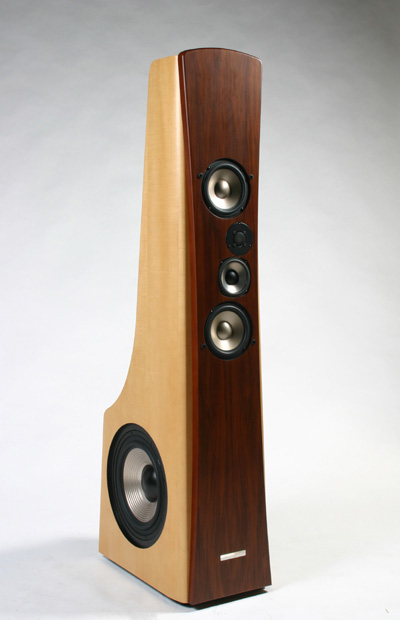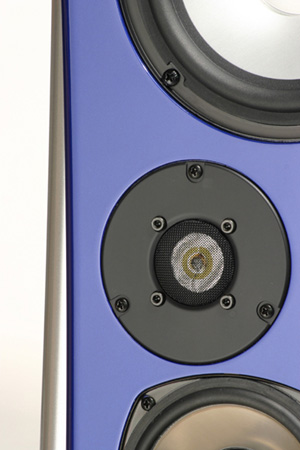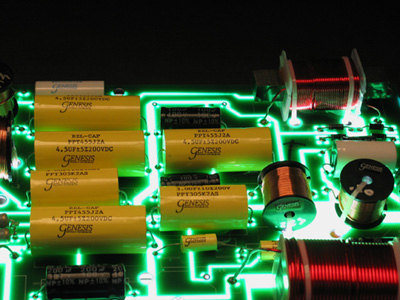You are reading the older HTML site
Positive Feedback ISSUE
18
march/april 2005
genesis
G6.1 loudspeakers
as reviewed by Karl Lozier

KARL LOZIER'S SYSTEM
LOUDSPEAKERS
ELECTRONICS
SOURCES
CABLES
ACCESSORIES
|
The designer of the Genesis Advanced Technologies G6.1 loudspeaker system is Arnie Nudell, along with electronics genius Bascom King. The company's CEO and managing director is Gary Leonard Koh. The COO is his sister, Carolyn Koh, who puts her MBA in international marketing to use by managing the company's worldwide distribution network. In 1967, Nudell was designing a pulse ruby laser to accurately measure the distance between an airplane and the ground below using a servo-feedback system to control the airplane's navigation system. He realized that a similar system could control the relatively large movements of a subwoofer. This seemingly simple idea became a fundamental building block of Nudell's first company, Infinity Loudspeakers, and he has been refining it for over thirty years. The result of a well-designed servo system is not more bass, but more accurate, cleaner, and less distorted bass, by as much as a factor of ten.
Nudell eventually sold Infinity. Next up was a move to Colorado and the forming of Genesis Loudspeakers, a company dedicated to making the highest-performing loudspeakers possible. With Gary Koh's purchase, the company was reborn as Genesis Advanced Technologies, and Arnie is now able to do his thing, which is to design loudspeakers.
I did not intend to pay particular attention to loudspeakers at this year's CES, but things turned out otherwise. I came to the conclusion that there had been a degree of improvement in the better loudspeaker lines. The improvements were subtle but apparent, even listening through the din and distractions of CES. Luckily (though not really, I am sure), companies such as Genesis, Nola, and Dali wound up in the larger rooms, and larger nearly always means better at CES. Genesis' was featuring their very large G201 system at their popular and crowded room. While talking with Arnie, my wife and I spied a particularly attractive pair of loudspeakers, and the beauty of the G6.1 system turned out to be more than skin deep. These svelte, attractive, five-foot tall enclosures—thankfully just one per side—hold bountiful goodies.
Each speaker enclosure has a pair of ribbed aluminum 12-inch subwoofers driven by a built-in, 500-watt, switching amplifier. The amplifiers are small, produce little heat, and are an ideal choice. The fact that they cover the range from below (yes, below) 20Hz to around 100Hz means that high-powered amplifiers are not needed to drive the rest of the system. High-quality, not high-powered, amplification is required for listening pleasure—anything less is a waste of time and money. I know of no other single-cabinet, full-range loudspeaker system that has more extended bass response, or any that has superior detail and clarity (i.e., lower distortion) in the bottom two octaves. The secret is Nudell's servo control of the subwoofers with the built-in amplifiers and an accelerometer in the feedback circuit. The published distortion figures are probably the lowest of any major loudspeaker.

Next up is a pair of 6.5-inch aluminum drivers. These can be considered woofers, but Genesis refers to them as midbass couplers. The description is accurate. Possibly surprising is the fact that they are not mounted adjacently—the titanium midrange driver and the circular 1-inch ribbon tweeter are mounted slightly off center between the two midbass couplers. The entire arrangement sounds like a single unit, with no audible hint of a crossover. There is no sense of "tweeter crawl," the sensation that an instrument moves upward as notes climb the musical scale. The midbass couplers and the titanium midrange drivers open to the rear of the front baffle, which makes them dipole radiators. The extremely thick front baffle has a slight, 5-degree backward tilt, which results in correct phase alignment and is one of a number of design features that explains the neutral and detailed performance of the G6.1s. The tweeter is not mounted to allow rear radiation. Instead, a second circular ribbon tweeter is mounted higher on the rear of the open-design cabinet. Unlike the front-mounted one, the rear tweeter does not have an output adjustment control.
To summarize, we can call the subwoofers omni-directional radiators over their rather limited frequency range and describe the rest of the system as operating in dipole mode. Why, you ask? There are two principal reasons. First, the rear radiation adds a great deal of ambience and soundstage depth. Changing the distance between the loudspeakers and the wall behind them can alter these effects. Similar changes can be had by adjusting the amount of absorbent material in the rear of the enclosures, but this is not recommended for home users. Second are the laws of physics that come into play with dipole radiation. Much of the side radiation at 90 degrees off axis is greatly reduced or cancelled, which causes a reduction of the sound bouncing off any wall to the side of the dipole radiators and adds significantly to the clarity of dipole speaker systems. I can testify to its effectiveness in my listening room.
The tweeter is a one-inch circular planar ribbon crafted from an extremely thin membrane of Kapton that has a photo-etched "voice coil" that is 0.0005 inch thick. If you picture how thin that is, you can appreciate that the entire radiating surface has less mass than the air in front of it. This lack of mass is a major factor in the G6.1s' ability to accurately reproduce frequencies beyond 35kHz. The tweeter's fantastically low mass allows superb transient response because it responds to a musical signal almost instantaneously, then stops on that famous dime. Low distortion is also inherent to this type of radiator. The response speed is said to be about the same as the best electrostatic or ribbon designs.

The rear-mounted tweeter is wired out of phase to the front one, to keep the dipole radiation mode consistent with the rear radiation of the midrange and midbass drivers. It is mounted higher on the rear baffle than any of the front-firing drivers, and this seems to be a major factor in the apparent height of the system's soundstaging and its vertical "reach" in my listening room. Shorter systems, even with angled tweeters, have never presented this effect. The result is more like what is heard in a concert hall. I have not heard its superior.
I feel I can say without hyperbole that the Genesis G6.1 loudspeaker system is an important design. It is not a collection of off-the-shelf drivers and parts. The only aspect of it that may not be unique is the midbass coupler. These drivers are the only ones not adjustable. All the other drivers are adjustable relative to them. The rated sensitivity of the speaker is 90dB at 1 watt and 1 meter. That rating is definitely above average. In addition to being an outstanding pair of loudspeakers for stereo reproduction, the G6.1s are at the heart of a unique multi-channel system that offers an almost unbelievable level of flexibility, with a variety of choices of subwoofers and surround-sound speakers. (Those interested should find the March/April 2004 issue of the recently-deceased Stereophile Guide to Home Theater magazine for a fine review by Steven Stone. The article is also available on the Ultimate AV website: http://ultimateavmag.com/speakersystems/304genesis/.)
The enclosures deserve more than passing mention, for several reasons. One is their attractive design. A 270-degree viewing reveals no straight lines, as in Mother Nature. Everything is subtly curved and visually flowing. Anyone into woodworking knows the great difficulty of making cabinetry without right angles. I understand that the enclosures took two years to become reality. The intricate fitting together of free-form panels had the bonus of a substantial reduction of cabinet resonances. The cabinet is just that—it is not a resonator. The G6.1s participate in a growing trend by having a contemporary look while retaining much of the traditional warmth of fine wood cabinetry. There is a nice choice of finishes, including dramatic automotive finishes. Unlike many competitive designs, which tend to have dark enclosures with black grille cloths, the G6.1s' standard finish is a very attractive combination of woods.
The Genesis G6.1s do not sound analytical. I think of analytical components as having an inherent character that emphasizes system flaws. The G6.1s, on the other hand, are so low in distortion that any source or system flaws are exposed, but are in no way emphasized or exaggerated. Their neutral balance can easily be adjusted to be a bit less revealing. The midrange drivers and the ribbon tweeters have a limited range of adjustment, but a range of plus or minus less than a decibel can make an almost shocking difference in such a revealing, extended speaker system. I firmly believe that high-end loudspeakers should offer at least some adjustment for their high-frequency drivers. Companies that say that their loudspeakers have flat response, or that they sound the way the designer intended and no adjustment is needed, put me off. I love to ask at shows if their loudspeakers sound the same in a large room with thick carpeting and drapes and overstuffed chairs as they do in a small room with a lot of glass, a tile floor, and so on.
If your closest Genesis dealer has a demo pair of G6.1s in his showroom or, even better, trusts you to borrow them over the weekend, I would suggest that you start by playing some of your old favorite discs to see how the speakers perform on the bass end. Try a disc with some bass drum thwacks or organ pedal notes. I recommend any of a large number of Reference Recordings. Two of the great ones are RR-93 (Copland) and RR-96 (Rachmaninoff). If you do not have these, try a few Telarcs. For a superb bass demonstration, try Epics (CD-80600), or the SACD of same. The third track, a suite from the movie Gladiator, is as good as it gets. Some of the tracks on Classics at the Pops (CD-80595 or the SACD version) are also outstanding, as is a new Telarc arrival (SACD-60631) of three choral suites from Ben Hur, Quo Vadis, and King of Kings. Not only does this disc feature the Cincinnati Pops, but the renowned forces of the Mormon Tabernacle Choir, and the result is somewhere between stupendous and spectacular.
Using my bass test discs, I learned that if the volume was kept to an almost-sane level, a pair of separate and reasonably well-placed subwoofers could keep up with the G6.1s in reproducing sustained deep organ pedal notes, but when evaluating quality instead of quantity, it was no contest. Bass pulses and subtle detail in the bass range were much more apparent with the G6.1s. Few competing models, at up to double the $9300 cost of the GG6.1s, come close to equaling them in bass quantity. Throw bass quality into the equation, and the G6.1s come out way ahead. Loudspeaker distortion is rather easily measured in the bass range, and the Genesis G6.1s are measurably superior to other two-cabinet speaker systems. The situation only changes when comparing them to some multi-enclosure loudspeaker systems with woofer towers jammed full of subwoofers and driven by separate amplifiers, some of which are more expensive than a pair of G6.1s!
I had hoped to discuss the G6.1's other drivers in similar detail, but I soon realized that attempting this with the midrange drivers and tweeters was somewhere between difficult and impossible. Midrange is intimately tied to the higher frequencies propagated by the tweeters, and it takes practice to listen attentively to just the midrange driver. If you manage to do so, you will realize that its lack of smear, and the resultant clarity, is due to the complete lack of breakup modes in its operating range. This is because the driver is machined from a solid piece of titanium, which is extremely light yet strong. The strength of the material allows perfect piston action, and its light weight allows for excellent transient response. The same lack of smear, and great clarity, can be heard with instruments that produce most of their energy in the treble range. Here, the unique, almost mass-less circular ribbon can show off its multiple-octave range. There is no "oil-can" resonance or rapid fall-off in the 10kHz to 20kHz range, as there is with more conventional tweeters. The frequency response curve of the Genesis G6.1 simply sails through that octave unimpeded, as well as most of the following octave.
Arnie's newly designed, low-mass, circular tweeter could be called a supertweeter, as it goes beyond the generally accepted range of human hearing. It is now fairly common to question that accepted range, as research indicates that the range of human hearing extends well beyond 20kHz when using pulses instead of steady tones. Great strides have recently been made in tweeter design, but I believe that the frequency range, wide dispersion, output level, and transient response of Arnie Nudell's ribbon tweeters cannot be surpassed by any moderately-priced loudspeaker design. That can be translated as saying, "It is the best."
To demonstrate the G6.1s' superb transient response (the stopping as well as starting of a note), play your best violin or piano recordings and see if the G6.1s aren't as clean as the proverbial whistle. If the sound is a bit bright, touch up those adjustment controls, one at a time. If it's a bit edgy or harsh, do some experimenting. That recording may not be quite as good as you thought. Or, heaven forbid, that new interconnect or loudspeaker cable, based on this or last year's latest (unproven) design, has a design flaw unnoticed by the only reviewer to have written about it. The possible culprits are numerous, but should not include the G6.1 loudspeakers, which function as evaluation tools. Outstanding recordings and ancillary components are clearly revealed. Not-quite-outstanding recordings and components are also revealed for exactly what they are, but beware, as you may have to eliminate compensating components or tweaks.
The midrange is where the music lives, and where audio systems (particularly loudspeakers) live or die. To live means that the listener experiences a degree of the real thing—live music. Arnie Nudell is justly proud of the heritage of his now-famous servo-controlled subwoofers. Though only one or two audio magazines currently publish audio response graphs, if they do, you will see that the Genesis subwoofers do not roll off until below 20 Hz. I do not remember seeing any other manufacturer's models that come even close to that. Arnie is a true music lover, and his designs are intended to enable accurate reproduction of the music he loves.
Recordings that have a natural midrange (not show-off recordings) should sound like the real thing on the Genesis G6.1 loudspeakers. The Mercury recording of Frederick Fennell conducting light classics for wind ensemble (434322-2) is superb. Also try Baroque Brass (Telarc SACD-60614), the piano recital by Lang Lang (Telarc SACD-60582), Heifetz doing three violin concertos (RCA SACD 82876-66372-2—just released and a gem), the Glazunov First for quiet beauty (Telarc SACD-63546), John Pizzarelli plus George Shearing and quintet (Verve V6-8606), Oscar Peterson Trio Get Requests (Telarc SACD-63603), The Manhattan Transfer at their mature finest plus Telarc's recording at its mature finest. So far, every AIX recording I have heard (www.aixrecords.com) offers a beautiful, relaxed, and real-sounding midrange. (Most also offer you-are-there visual realism on the flip side for your DVD player, but be warned that the audio-only side requires a DVD-Audio player or a truly universal player.)
The impressive Genesis G6.1 loudspeakers offer performance that may not be surpassed, at any price, by any other single-enclosure-per-side loudspeaker system. Clean, clear, low-distortion response is what sets the G6.1 loudspeakers apart. I rarely resort to hyperbole, and hope I do not lose credibility by finding yet another truly outstanding product. A few months ago, I found an outstanding value in DiMarzio's Super M path loudspeaker cables. Last month, in my review (the first in the U.S.) of Herron's new VTSP-2 preamplifier, I found it the equal of any at any price, and this has since been confirmed by worldwide reviews. Now I can be the first to let you know about the Genesis G6.1 loudspeakers. I find them unequaled by any competitor known to me, at up to double the G6.1s' list price of $9300 per pair, and unsurpassed in any measurable performance category in their price range.
Though at five feet, the G6.1s may be taller than some people prefer, but they do not look large or bulky. I would describe them as svelte and extremely attractive. They do not seem to dominate most rooms, and I found them to be relatively noncritical in placement. The manual is downloadable from the Genesis website, and is one of the best I have ever seen. The Genesis G6.1 loudspeakers have my highest recommendation, and I regard them as an outstanding value. Karl Lozier
G6.1 loudspeakers
Retail: $9300 a pair in rosewood
Genesis
web address:
www.genesisloudspeakers.com
